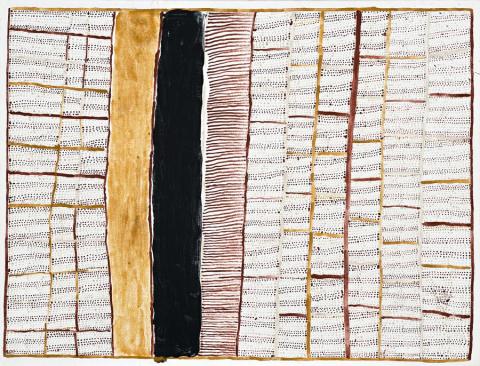JILAMARA, 1999
KUTUWULUMI PURAWARRUMPATU (KITTY KANTILLA)
natural earth pigments and synthetic binder on canvas
78.5 x 102.0 cm
inscribed verso: artist's name, date and Jilamara Arts and Crafts catalogue number KK99MC
Jilamara Arts and Crafts, Melville Island
Private collection, Sydney
Ryan, J., Kitty Kantilla, National Gallery of Victoria, 2007, p. 59 & 68
Kitty Kantilla (Kutuwalumi Purawarrumpatu) was the first Tiwi artist to be the recipient of a retrospective exhibition at a major Australian art gallery. Held at the National Gallery ofVictoria and The Art Gallery of New South Wales between April 2007 and January 2008, the exhibition was a celebration of the work of one of the most prominent Tiwi artists. Kantilla is regarded as one of Australia's most accomplished indigenous artists, her work attracting widespread acclaim and she is credited with significantly raising the profile of Tiwi art.
Kantilla was born in Yimpinari country, Melville Island, and commenced her artistic career in the late 1980s at the age of fifty, producing ironwood sculptures for two group exhibitions in Sydney and Melbourne, in association with Tiwi Pima on Bathurst Island. In 1989, she moved to Milikapiti on Melville Island beginning a long association withJilamara Arts and Craft. Here she worked daily developing her skills.
Having gained a considerable recognition over a short period of time, there was a huge demand for her work. And, as she painted exlusively for Jilamara Arts and Craft, this produced good relationships with select galleries.
Kantilla's work represents the expression of cultural memory and passing it on to generations. Her father taught her the jilamara - ''I've still got the design in my head.' Refusing a widows pension, Kantilla wanted to make herself a living out of her art and often referred to her work as pumpuni jilamara - 'a good design'.1 Rarely using her full Tiwi name, she exhibited under the name of Kitty Kantilla and was lovingly referred to at Milikapita as Dot-Dot or the 'queen'.
Based on the traditional patterned, geometrical and abstract designs of Tiwi art to describe dreaming stories taught by her father, Kantilla created work in a variety of mediums: paper, canvas, bark, ironwood sculptures, as well as limited edition prints - all in the distinctive Tiwi palette of rich and creamy ochre tones. Every dot and line she paints convey traditional meanings, especially those of the Tiwi burial ceremony, Pukamani. This ceremony is central to Tiwi spiritual beliefs in which a variety of geometric designs are painted on both participants and burial poles.
Kantilla's work is both subtle and strong, balanced and fluid. The placement of delicate, intricate lines of dots, combined with traditional patterns and bold areas of ochre, bring a freshness and innovation to her works.
1 Ryan, J., Kitty Kantilla, National Gallery of Victoria, 2007 p. 75
